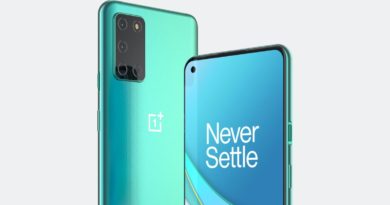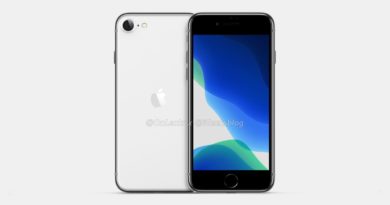Google Pixel 5 vs. Samsung Galaxy S20: Which Android flagship will win?
Since February, the Samsung Galaxy S20 has been high up on our list of best Android phones. It’s managed to hold onto this position up to now, but the next big challenger for its place in the pecking order is Google Pixel 5.
The Pixel 4 and the larger Pixel 4 XL had lots of smart ideas when they launched in October last year. However, they had many flaws too, which translated into solid review scores but poor sales. Fortunately, it’s time for Google to try again, and the rumors we’ve heard suggest there are big changes planned for the Pixel 5 — changes that may help the Pixel 5 challenge Samsung’s least-expensive flagship, the Galaxy S20.
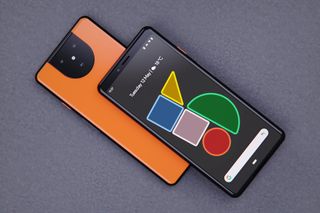
Even though we don’t have the final specs for the Pixel 5, there have been enough reliable leaks for us to get a decent handle on some of the features it’ll bring. Therefore, we’ve compiled this preliminary Google Pixel 5 vs Samsung Galaxy S20 face-off to offer some insight as to which phone looks as if it’ll be the superior Android flagship.
Google Pixel 5 vs. Samsung Galaxy S20 specs
| Google Pixel 5 (rumored) | Samsung Galaxy S20 | |
| Starting price | $699 | $999/£899 |
| OS | Android 11 | Android 10 |
| Display | Unknown | 6.2-inch quad-HD AMOLED (3200×1440) |
| Refresh rate | 90Hz | 120Hz |
| Processor | Snapdragon 765, 765G, 768G, 775G or 865 | Snapdragon 865 |
| 5G | Yes | Yes |
| RAM | 8GB | 12GB |
| Storage | 128GB | 128GB + microSD expandability |
| Battery | Unknown | 4,000 mAh |
| Rear cameras | 12MP main, ultrawide and telephoto (resolutions unknown) | 12MP wide, 12MP ultrawide, 64MP telephoto |
| Front camera | Unknown | 10MP |
| Size | Unknown | 5.9 x 3 x 0.31 inches (149 x 76 x 8 mm) |
| Weight | Unknown | 5.7 ounces (161.5 grams) |
Pixel 5 vs. Galaxy S20: Price and availability
The Galaxy S20 5G went on sale in February 2020 for $999/£899. In the U.K., where Samsung offers a 4G LTE-only option as well, it starts at £799.
The Pixel 5 hasn’t been released or even announced yet, but will likely appear around October, as the Pixel 4 did in 2019 and the Pixel 3 did in 2018. Based on rumors, we’re hoping the Pixel 5 will have a cheaper starting price than the Galaxy S20, perhaps around $799/£699, in order to undercut the competition and provide a lift to Google’s flagship sales, where the company has been struggling to make progress. In fact, the Pixel 5 could begin as low as as $699, based on a survey Google distributed to some of its customers asking what they’d pay for a “premium Pixel” back in May.
Pixel 5 vs. Galaxy S20: Design and display
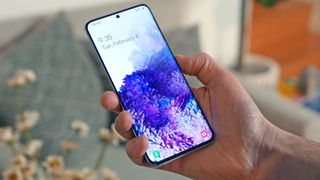
In a nutshell, the Galaxy S20’s design is plain but functional. With a central punch-hole in its subtly-curved display, and a plain black rectangular camera bump on the back, it’s unfussy in a way that likely appeals to many phone buyers.
Samsung offers its most interesting set of colors on the standard S20: a trio of Cloud Pink, Cloud Blue and Cosmic Grey. Some retailers in certain regions even offer Cosmic Black, Cosmic White and a bolder Aura Blue hue, though these are unavailable if you opt to buy your S20 directly from Samsung.
Google tends to make slightly more unique looking phones than Samsung, although they’re often divisive as a result. Examples include the multi-textured glass used on the Pixel 3, or the Pixel 4’s thick top bezel, which was made larger than the rest to house the phone’s Soli radar and 3D facial authentication system.
The Pixel 5’s design isn’t yet agreed upon by the big leakers, so we don’t know for sure what it’s going to look like. One version, first leaked by FrontPageTech, claims it will have a new U-shaped rear camera bump yet carry the same front bezel as the Pixel 4. Another popular idea points to the square rear camera block of the Pixel 4, but the punch-hole front-facing camera of the as-yet unreleased Pixel 4a.
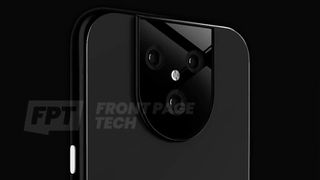
For colors, Google typically offers a white version, a black version and a third more colorful option. The Pixel 4 had Oh So Orange, so we’re interested to see what this year holds. If history is any indication, we expect it to be even more vivid than the pink or blue hues that the S20 offers.
Samsung made a big leap with the S20’s display this year by giving it a QHD resolution and a 120Hz refresh rate (although not both at once, unfortunately). At 6.2 inches across, it’s on the smaller end of Android flagship screens, so it offers a good balance of big screen enjoyment and everyday portability.
Google has typically offered a standard and XL version of its Pixels, with last year’s Pixel 4 measuring 5.7 inches and the Pixel 4 XL measuring 6.3 inches. We can probably expect something similar this year, perhaps a little larger thanks to a bigger chassis and potentially no bezel. The Pixel 4 introduced a 90Hz display to the Pixel series, and therefore it’s quite likely we’ll see it either return or get upgraded to the 120Hz refresh rate that’s quickly become the standard for Android phones.
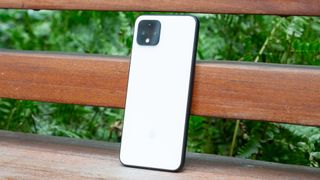
Pixel 5 vs. Galaxy S20: Cameras
The Galaxy S20 uses three rear cameras: a 12MP main camera, 64MP 3x optical telephoto camera and 12MP ultrawide camera. There’s also a 12MP front camera. In comparison, the Pixel 5 is thought to be equipped with the same kinds of lenses — main, telephoto and ultrawide along with a single front camera — but we don’t know the sensors’ resolutions yet. Google hasn’t historically been obsessed with huge amounts of megapixels, so expect these cameras to weigh in at about 12MP apiece, rather than the 64MP or even 108MP cameras that Samsung has in its arsenal.
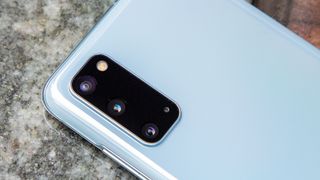
Where Google instead aims to beat the competition is with its awesome image post-processing, which tidies up and beautifies your shots quite impressively, adding effects like bokeh and boosting colors selectively for optimal results. Google’s Night Sight mode is also one of the industry’s best executions of night mode — second perhaps only to Apple’s, depending on the photo op.
Samsung has equivalent technology, and its own unique Single Take feature that snaps multiple kinds of shots all at once for you to then pick the best from. However, the S20’s computational photography tricks aren’t class leading in the same way that the Pixel 4’s were. It’ll likely have a hard time keeping up with whatever improvements Google delivers in its 2020 flagship.
Pixel 5 vs. Galaxy S20: Performance
The Galaxy S20 uses the Snapdragon 865, the top 5G-enabled CPU offered by Qualcomm right now. However, the S20 only gets this chip in the U.S. If you buy it elsewhere, Samsung sticks its own Exynos 990 in there instead, which offers comparable performance and 5G compatibility at the expense of a little less overall power.
The Pixel 5’s chipset is a mystery, but the most likely bet right now is not the Snapdragon 865, but Qualcomm’s new 7-series silicon: potentially the Snapdragon 765, 765G, 768G or rumored 775G. All of these are a comparable in performance to one another, yet a noticeable step down from the 865 chip. That said, all the 7-series CPUs do still offer 5G, which would ensure the Pixel 5 is just as future proof as the S20 in terms of network connectivity. These less-powerful chips might also help Google reach a lower price for the Pixel 5 relative to the expensive Galaxy S20 line.
For RAM, we’d expect the Pixel 5 to use at least 8GB, since this is what the Pixel 4a is also rumored to be employing, after Google included 6GB on the Pixel 4. The S20 gets 12GB RAM, which will only make the performance gap wider, but doesn’t necessarily mean a huge leap in potential, unlike the CPU difference.
If you want a benchmark comparison, we can look at the scores achieved by the Galaxy S20 and the Pixel 4 XL for clarity, although the Pixel 4 series used significantly less RAM and an older Snapdragon 855 chip that will still likely beat out the 7 series’ performance. The S20 scored 3,147 on Geekbench 5’s multicore test, while the Pixel 4 managed 2,329. We predict a similar if not even greater difference in scores for the Pixel 5 and the S20, considering the use of Snapdragon 7-series processors.
Pixel 5 vs. Galaxy S20: Battery life and charging
Battery life could be a close competition for these two phones. The Samsung Galaxy S20 contains a 4,000 mAh battery, which can charge at 25W with the included wired charger, and up to 15W wirelessly.
The S20 achieved 9 hours and 31 minutes on the Tom’s Guide battery test when set to its 60Hz refresh rate, which isn’t particularly good to start with. Yet that only got worse at the S20’s maximum 120Hz setting, where it managed a paltry 8 hours and 4 minutes before dying.
There’s no specific rumors about the Pixel 5’s battery yet. Still, we hope Google will incorporate a battery with greater capacity than the small 2,800 mAh unit inside the regular Pixel 4, or the 3,700 mAh one within the Pixel 4 XL. We also expect those handsets’ 18W wired and 10W wireless charging abilities to return in the Pixel 5 at the very least.
However, inferior specs on paper wouldn’t necessarily matter if the Pixel 5 can use its power efficiently. On Tom’s Guide’s battery test, the Pixel 4 XL achieved 9 hours and 42 minutes at its fixed 90Hz refresh rate. That’s still not great, but it is better than the S20’s poor result, even at Samsung’s lowest refresh rate setting. Hopefully Google can make that gap even wider with the Pixel 5 and still overcome that potential wired and wireless charging speed deficit.
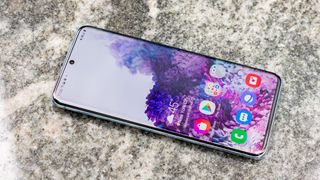
Pixel 5 vs. Galaxy S20: Software and special features
Software is one of the areas where these two phones are expected to diverge the most. Samsung’s version of Android 10, One UI 2.0, is heavily modified to add in lots of Samsung-specific apps, whether you want them or not. There’s great integration with the basic Android 10 features like dark mode, Google Duo video calling etc., but then you also have features like Bixby. Samsung’s proprietary digital assistant isn’t really a competitor to Google Assistant, or Siri for that matter, but it’s still there, taking up valuable storage space.
The Pixel 5 will most likely come with the stock Android experience we’ve seen on previous Pixels. Although it isn’t unique to Pixel phones, Google always brings out the newest version of Android with its Pixel launch that year, this time around being Android 11, so we’re expecting to see that on the Pixel 5 from launch. In previous years, Google has introduced big upgrades to its Assistant with the Pixel launch, so we may see this again this year. It may not have as many flashy features or pre-installed apps to play with, but we appreciate the Pixel series for how tidy and efficient its user experience is.
Another interesting question relates to what features the Pixel 5 may lose from its predecessor. In an effort keep costs down, Google has been rumored to strip its forthcoming flagship of its exclusive Soli short-range radar system, which enables Motion Sense air gestures.
Google may also scrap 3D face unlock, which would particularly be a shame because facial authentication on the Pixel 4 was executed very well and, in some cases, proved even more responsive than Apple’s Face ID system in the iPhone 11 series. If we had to make an educated guess, we’d say that Motion Sense is more likely to get the axe based on its limited appeal, but Google eliminating either feature remains the stuff of rumors for now.
Pixel 5 vs. Galaxy S20: Outlook
Once the Pixel 5 is released, it’s going to touch off an interesting duel with Samsung’s entry-level flagship. With Google poised to change so much about what it considers a flagship product, and Samsung having brought out some of its most ambitious hardware in years inside the Galaxy S20, hopefully this will be a close and fruitful competition between two top-tier rivals in the Android flagship space.
For what it’s worth, both tech giants do have a bit of a reputation of shipping devices in buggy states, and Samsung’s enjoyed an advantage of getting its product out the door many months before Google will. That could mean trouble for the Pixel 5 at launch, though we won’t know for certain until Mountain View’s next premium phones emerge this fall.
